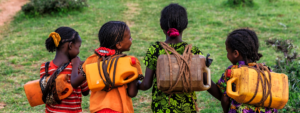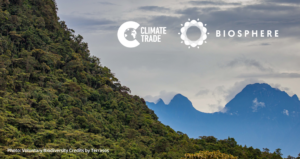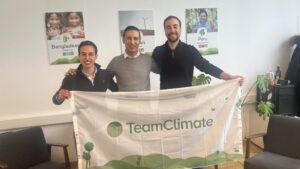
From carbon offsets to biodiversity and plastic credits, this article is a detailed explanation of the different types of climate assets you will find on the ClimateTrade marketplace.
Are yo confused about the difference between carbon avoidance and removal? Afforestation and reforestation? Do you understand the role of standards like Verra or the Clean Development Mechanism in the voluntary carbon market? Fear not: we answer all your questions about climate assets in this article.
Carbon offsetting
As a climate marketplace, ClimateTrade’s primary focus is decarbonization. That’s why carbon credits are the main product on our platform. These credits, sometimes called ‘carbon offsets’, are generated by sustainable projects that either avoid emissions or absorb carbon through their activities. They can then be purchased by companies or individuals that wish to offset their own carbon emissions: one carbon credit equals one ton of CO2.
The voluntary carbon market (where all credits on the ClimateTrade marketplace come from) is not heavily regulated by governments, but it does comply with a number of industry-created rules. To create a carbon offset, project developers must comply with the standards established by carbon registries, provide documentation, prove third-party verification, and monitor their projects. Carbon registries act as a third party between project developers and buyers to ensure that the offsets sold deliver the promised environmental impact in a transparent and traceable way.
Carbon standards
Standards are either used to verify that a project actually achieves the carbon reduction it claims (quantitative standards), or to guarantee other types of impacts (non-quantitative standards).
Quantitative emissions reduction standards
These standards have standardized methods to determine the carbon emission reductions achieved by a carbon offset project.They include:
- Verra’s Verified Carbon Standard (VCS), a global and widely used greenhouse gas (GHG) crediting program that aims to drive finance toward activities that reduce and remove emissions, improve livelihoods, and protect nature
- Gold Standard, a program launched in 2003 by WWF and other international NGOs to ensure projects that reduced carbon emissions featured the highest levels of environmental integrity and also contributed to sustainable development
- The Climate Action Reserve, a North American environmental non-profit organization that promotes and fosters the reduction of GHG emissions through market-based policies and solutions. The Reserve has the particularity of acting both on the voluntary carbon market and on California’s mandatory Cap-and-Trade Program.
- The American Carbon Registry, a U.S-based non-profit enterprise of Winrock International founded in 1996 as one of the first private voluntary greenhouse gas registries in the world
- The Clean Development Mechanism, launched as part of the Kyoto Protocol to allow countries with emission reduction or limitation commitments under the Protocol to implement emission reduction projects in developing countries, generating Certified Emission Reduction (CER) credits that each represent one ton of CO2
All the standards above also serve as registries, helping to verify, certify and track carbon offset projects to avoid double counting on the voluntary market. Each standard and registry focuses on a specific range of carbon mitigation technologies, and can therefore be applied only to certain types of projects (see ‘Types of carbon mitigation projects’ below).
Non-quantitative standards
The following qualitative standards were designed to complement the emissions reduction standards above, certifying social or other ancillary impacts beyond carbon. Examples include:
Types of carbon offsetting projects
There are many variations within the carbon credit category, as each project uses one or several methods to avoid or remove carbon from the atmosphere.
Carbon avoidance vs carbon removal
Certain projects serve to avoid the emission of greenhouse gases that would result from polluting activities: they are called carbon avoidance projects. They include projects that protect areas from deforestation or agriculture, or renewable energy projects that reduce the need for fossil fuel energy generation.
But the wide majority of carbon mitigation projects focus instead on removing carbon that has already entered our atmosphere: they are carbon removal projects. They include natural and technological removal, such as afforestation (planting trees in areas that didn’t previously have a forest), reforestation (replanting trees in areas that have been deforested), soil carbon sequestration (through carbon farming, for instance) and direct air capture through devices such as the BioUrban, amongst others.
Energy
Many types of energy projects can generate carbon credits. In this category, you will find hydropower, wind and solar projects, as well as projects that generate energy from heat (geothermal) or landfill gas. Some initiatives focus on avoiding methane emissions from industry or improving energy efficiency in factories, while others seek to implement cleaner or more efficient energy solutions within communities (for instance through clean cooking stoves).
Within these energy projects, some are certified by the Carbon Offsetting and Reduction Scheme for International Aviation (CORSIA), and are therefore eligible for airlines’ carbon offsetting schemes.
Forest management
The other main type of carbon offsetting projects on the ClimateTrade marketplace focuses on forest management: afforestation, reforestation, forest carbon and REDD+ (a framework created by the UNFCCC Conference of the Parties to guide activities in the forest sector that reduces emissions from deforestation and forest degradation, as well as the sustainable management of forests and the conservation and enhancement of forest carbon stocks in developing countries).
Renewable energy (I-REC)
Beyond carbon offsetting projects, you will also find a ‘renewable energy’ category on the marketplace. Unlike the projects mentioned above, which generate carbon offsets, these generate a specific type of credit, called Renewable Energy Certificates (RECs). RECs represent the environmental attributes of the generation of a one-megawatt hour (MWh) of energy produced by renewable sources, and they can be purchased to prove the renewable origin of electricity purchased from the grid. As such, they represent emissions reductions from the buyer’s value chain: a switch from conventional to renewable electricity.
RECs are certified by the International REC Standard (I-REC).
Contribution: future carbon and beyond
Finally, the ClimateTrade marketplace also features so-called ‘contribution’ projects. These are not (yet) certified for emissions reduction, but present many other social and environmental benefits such as gender equality or biodiversity protection. Some don’t focus on carbon at all: that’s the case of plastic removals or coral conservation projects. In this category, you will also find an innovative type of credit: voluntary biodiversity credits that protect and restore fauna and flora over a specific area.
Contributions of this type are key to get these holistic projects up and running, bringing countless benefits to the planet and to local communities.
- SEO Powered Content & PR Distribution. Get Amplified Today.
- Platoblockchain. Web3 Metaverse Intelligence. Knowledge Amplified. Access Here.
- Source: https://climatetrade.com/a-guide-to-climate-assets-on-the-climatetrade-marketplace/
- 1
- 1996
- a
- About
- above
- achieved
- Achieves
- Act
- Action
- activities
- actually
- agriculture
- aims
- AIR
- All
- already
- American
- amongst
- and
- answer
- applied
- AREA
- areas
- article
- Assets
- Atmosphere
- attributes
- aviation
- avoiding
- below
- benefits
- between
- Beyond
- Bringing
- buyers
- called
- capture
- carbon
- carbon credits
- carbon emissions
- Carbon Reduction
- Carbon Sequestration
- case
- Category
- certain
- certificates
- Certified
- certify
- chain
- claims
- Climate
- co2
- come
- Communities
- Companies
- Complement
- Conference
- confused
- CONSERVATION
- contributed
- contribution
- conventional
- cooking
- Coral
- countries
- create
- created
- credit
- Credits
- decarbonization
- deforestation
- deliver
- designed
- detailed
- Determine
- developers
- developing
- Developing Countries
- Development
- Devices
- difference
- different
- direct
- documentation
- Dont
- double
- drive
- each
- efficiency
- efficient
- either
- electricity
- eligible
- emission
- Emissions
- energy
- energy efficiency
- energy projects
- Energy Solutions
- ensure
- entered
- Enterprise
- environmental
- equality
- Equals
- established
- examples
- explanation
- factories
- fear
- featured
- Features
- finance
- Find
- First
- Focus
- focuses
- following
- forest
- Fossil fuel
- Founded
- Framework
- from
- Fuel
- future
- GAS
- Gender
- generate
- generated
- generating
- generation
- get
- GHG
- GHG emissions
- Global
- Governments
- greenhouse gas
- Grid
- guarantee
- guide
- heavily
- helping
- highest
- holistic
- HTTPS
- Hydropower
- Impact
- Impacts
- implement
- improve
- improving
- in
- include
- individuals
- industry
- initiatives
- innovative
- instance
- instead
- integrity
- International
- IT
- Key
- Kyoto Protocol
- launched
- levels
- limitation
- local
- Main
- Majority
- management
- mandatory
- many
- Market
- marketplace
- mechanism
- mentioned
- methane
- methane emissions
- methods
- mitigation
- Monitor
- more
- more efficient
- Natural
- Need
- NGOs
- non-profit
- non-profit organization
- North
- number
- offset
- ONE
- organization
- Origin
- Other
- Others
- own
- part
- parties
- party
- planet
- Planting
- planting trees
- plastic
- platform
- plato
- Plato Data Intelligence
- PlatoData
- policies
- present
- previously
- primary
- private
- Produced
- Product
- Program
- project
- projects
- promised
- promotes
- protect
- protection
- protocol
- Prove
- provide
- purchased
- qualitative
- quantitative
- Questions
- range
- reduce
- Reduced
- reduces
- registry
- regulated
- removal
- remove
- removing
- Renewable
- renewable energy
- represent
- Reserve
- result
- Role
- rules
- running
- scheme
- schemes
- sector
- Seek
- sequestration
- serve
- several
- Social
- solar
- sold
- Solutions
- some
- Sources
- specific
- standard
- standards
- Stocks
- such
- sustainable
- Switch
- technological
- Technologies
- The
- The Projects
- their
- therefore
- Third
- third-party
- Through
- to
- Ton
- topic
- toward
- track
- transparent
- Trees
- types
- under
- understand
- value
- VCs
- Verification
- verified
- verify
- which
- while
- wide
- widely
- will
- wind
- within
- would
- Your
- zephyrnet












